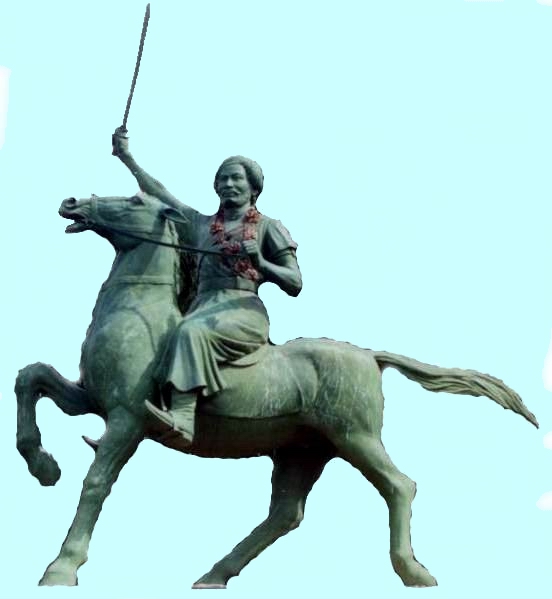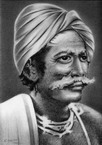


In Search of the Real Birth Place of Surendra Sai
Up to 1984, it was a well known fact that Surendra Sai was born at Bargaon (near Dhama), at his maternal uncle’s place; as mentioned by Siba Prasad Dash in his book “History of Sambalpur”. The then Governor of Orissa also unveiled a statue of Surendra Sai, at Bargoan on 13 April 1977.
While celebrating the birth centenary of Surendra Sai in the year 1984 Sri Biswambar Nath Pandey the Governor of Orissa unveiled a statue of Surendra Sai at Sambalpur. The same day, a book on Surendra Sai written by Prof Nabin Sahu, published by the Culture department of Government of Orissa was also released. He mentioned that Surendra Sai was born at Khinda (a village on the Sambalpur – Jharsuguda highway) - not Bargaon. He disputed the statement of Siba Prasad Das, the author of “History of Sambalpur”, on the ground that women once married to the Chowhan dynasty never went back to their parental houses (as stated by Siba Prasad Das). Sahu fortified his statement by stating the example of Mitrabhanu Sai, who after returning from prison, was forced to stay at Bonai.
This statement of Nabin Sahu created turmoil in the people’s mind regarding the birthplace of Surendra Sai. Three famous historians could not be unanimous regarding the birth place of Surendra Sai. Prof Ghanashyam Das and Siba Prasad Dash are of the opinion that he was born at Bargaon and Prof Nabin Sahu was for Khinda. Further, there crops another dispute regarding the accurate placement and position of “Kudopali” where Chabila Sai was killed.
Dr Nabin Sahu and Siba Prasad Dash mentioned two different Kudopalis. Dr Nabin Sahu had written and further supported it with a map in his book that Chabila Sai was killed at Kudopali near the hills of Papanga. However, Siba Prasad Das mentioned that the Kudopali where Chabila Sai was killed by a bullet shot is near Sindurpank. Dr Hare Krushna Mahatab, known as another eminent historian of Orissa had written in the preface of Dr Nabin Sahu, that, he was able to give a true life sketch of Surendra Sai in his book. This disputed the earlier statement of two great historians of our time Prof Ghanashyam Das and Siba Prasad Dash.
Mitrabhanu Panigrahi, a direct descendent of Mrutunjaya Panigrahi (a very trusted and close associate of Surendra Sai), got a letter from one Amritlal Sahu of Ghens, Bargarh in the year 1981, to inquire about one Faira Majhi. A girl who was collecting information on Madho Singh, Kunjel Singh, Kamal Singh got some palm leaf documents from the Bhopal archive where she found mention of this Faira Majhi. She came to Amritlal with the entire document and requested information on Faira Majhi of Bargaon.
In his letter to Mitrabhanu Panigrahi, Amritlal wrote that, Faira Majhi was in possession of a letter written by Kunjal Singh and Kamal Singh to Surendra Sai. Further he mentioned that a man called Tuhara Raigi had salvaged a letter from the stable of Surendra Sai. This was written by Kunjal Singh and Kamal Sight to Chand Bhup Singh. (The said letter along with 19 other letters was placed before the court during the trial of cases of the freedom fighters of Sambalpur). The letter Faira Majhi got was written by close associates of Surendra Sai like Loknath Panda/Gadtia - Gountia of Rampella, Mrutunjaya Panigrahi - Gountia of Arda, Jagabandu Hota - Gountia of Papanga, Padmanave Guru - Gountia of Dulampur and Trilochan Panigrahi - Gountia of Daspur uncle of Mruntanjaya Panigrahi. The content of that letter is given below:
“You and Khageswar while departing from us have told to continue the struggle and not to surrender till the day you are crowned as the king of Sambalpur. As per your wish and instructions we are keeping the struggle alive and we shall continue to do so, and shall never surrender. Gountia’s had written to you that they have appealed to make someone the king of Sambalpur, but Impe rejected the appeal and punished “Pandaba”. Gountia’s are telling that they would come with 500 people and would cross the river at Dhama, and along with you from Bargaon shall go to the hills of Papanga, and create disturbance so that the Sahibs would be worried and would be happy to make someone the king of Sambalpur.” (The association of Surendra Sai with Bargaon cannot be disputed as Jagabandhu Hota a very close associate of Surendra Sai was also with him at Asirgarh jail was the Gountia of Papanga. Hence during that period some warfield was sure to be there near Papanga. Several caves are there in the hills of Papanga and it is said that, a lot of weapons used by Surendra Sai are still there.) The mention of Papanga and the revolt in the above letter makes it clear that Chabila Sai was killed at Kudopali near the Papanga hills.
Further, from the above statement it is clear that Surendra was very closely associated with Bargaon. How was it possible? Prof Sahu in his book on page 262 had writhen that in the records of Asirgarh prison the birth place of Surendra Sai was mentioned as - a resident of Sambalpur born at Bargaon. And the address of Mitrabhanu Sai is entered as Khinda. Here one can question why it was written so. The stable of Surendra Sai was at Bargaon. Further, the Gountias would take Surendra from Bargaon and go the hills of Papanga. The king’s store house of grain was at Bargaon. His Gadh (fort) was at Dhama, (Dhama other wise known as Dhamagarh, and people of Dama are called Dhamagadia)
It was true that no members of the royal family or Chowhans were leaving at Bargaon. In spite of that how could two great historians of our time wrote that Surendra Sai was born at Bargaon? It was a well known fact that the Chawhans’ were not only marrying the women of their dynasty - they were also marrying women of other castes as well. The first Chowhan king of Sambalpur had five wives; two of them were not from the royal family. Hence, it is presumed that Dharam Sai (father of Surendra Sai) was married to some one outside the royal family. Other wise how could Faira Majhi of Bargaon was so close to Surendra Sai, or how could he be in the possession of the letter of Kunjel Singh which was written to Surendra Sai? The locals of Bargaon are of the opinion that Faira Majhi, a man of the Gond caste, became a close relative of Dharam Sai by way of his marriage and later acted as a care taker and a close associate of Surendra Sai.
It is a known fact that after “Gandmaru” the Gonds cut-off all relations from the Brahmins, to the extent that they did not even accept water from them. (This pride of the Gonds has been vividly described, by Sradhakar Supkar in his play Surendra Sai). In 1962 in a feast (the ritual follows death) at Bargaon the Gonds were rigid that they would not touch any thing of Bargaon - even water. They insisted that water should be brought from other village for cooking purpose and it was done so. On inquiry, it was brought to light that a girl from the Gond tribe married a Chawhan, which had brought disgrace to the tribe.
In like wise manner the Chowhan of Khinda were also annoyed with Dharam Sai because he married a Gond girl, and they had taken a vow that they would kill the child born of this wedlock. At that time the wife of Dharam Sai was in the family way, she persuaded him (Dharam Sai) and came to Bargaon her parental house and gave birth to a boy child on 23rd January, 1809. That child later enthralled the area as the valiant warrior Veer Surendra Sai, who fought an epic struggle against the British Rule which is recorded in golden letters in the history of India's struggle for independence.
Dilip Kumar Padhi VU2DPI
Hotel Sujata, Sambalpur - KOSHAL - 768 001